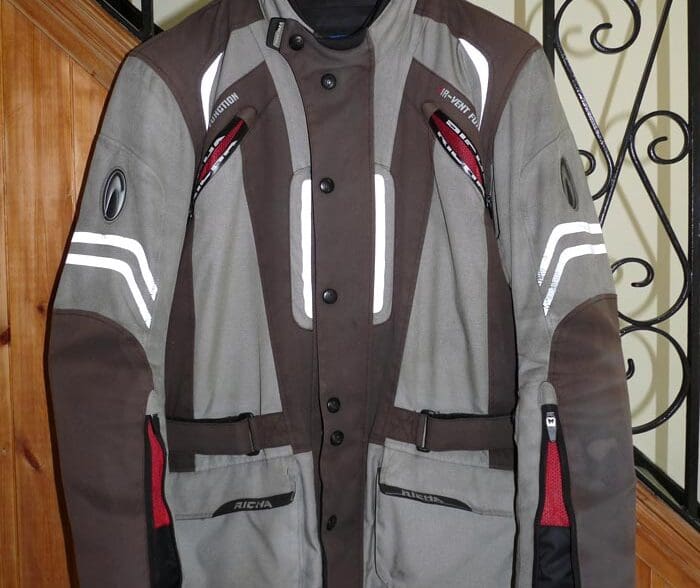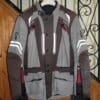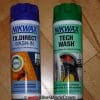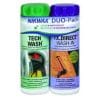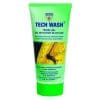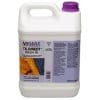This is an introduction to “Durable Water Repellency” (DWR) and a review of Nikwax Tech Wash and Nikwax TX Direct. webBikeWorld reader Nevin Power submitted this report, a veritable treatise on using Nikwax products to wash and re-treat a typical textile motorcycle jacket. The article describes how to save some money by bringing old and tired textile motorcycle outfit back to life.
There are several products that can be used to do this, but Nikwax is an old and trusted name, with one important fact: no fluorocarbons are used in Nikwax ingredients. This is an important point that Nikwax covers in detail in this page on their website.
Note that neither of us have any connection to Nikwax other than as satisfied customers. We’re short on photos for this article, as there isn’t much to illustrate, and it may be more than you’d ever want to know about Nikwax, but I think this is good information to provide to our readers.
Many of you have asked over the years about cleaning textile motorcycle gear and the waterproof issue. Note that this article is in the new webBikeWorld responsive format, which includes shorter paragraphs with more white space and a larger font for easy reading on everything from smartphones to tablets to the desktop. I hope you enjoy Nevin’s article.
Introduction
Nobody likes a leaky motorbike jacket. Surely then, everyone should like a product which claims to restore the waterproofing in your jacket? The thing is, such products have a patchy history and often when a jacket begins to leak, people see that as the first sign that they need to start flicking through the various bike clothing websites and budgeting for new gear at the local dealer.
We all enjoy looking through the new kit that the likes of Alpinestars et al bring out year on year, but if you ride daily and find yourself going through jackets or trousers as often as you do brake pads, then the cost is surely going to start adding up.
This is where Nikwax comes in. Nikwax is a British company that make a range of products for outdoor enthusiasts and two of those products are particularly useful for motorcycle owners.
Nikwax Tech Wash and TX Direct are two products which, when combined, clean your gear and revitalise the waterproofing built in them from the factory.
It might sound a little far-fetched, but waterproofing technology — beyond just putting a one-piece impregnable plastic suit over yourself and drowning in your own sweat — has been with us for decades.
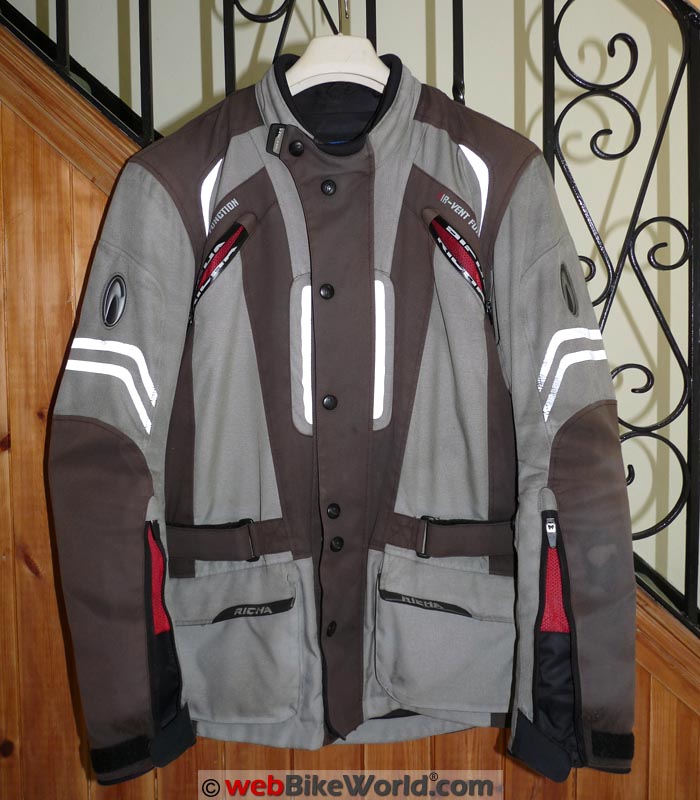
What is “Durable Water Repellency”?
While the technology has been around for decades, it has not always filtered down to motorcycling gear, with waxed cotton and dubbin-covered leather the key to staying somewhat dry on a wet ride for many years. However, particularly over the last twenty years, there has been an explosion in the quality of the technology now incorporated into technical motorcycle fabrics.
Waterproof and breathable membranes such as Gore-Tex (report), brought to the market in the 1970s, are now commonplace and have been previously discussed here on webBikeWorld.
What we tend to forget about however, is the DWR coating which lies, microscopically, on the very top layer of the jacket or trouser you wear on your bike.
DWR stands for “Durable Water Repellency” and is a coating that helps your waterproof membrane, be it Gore-Tex, Sympatex or other brand name, to work properly by preventing water from soaking, or “wetting out”, the outer layer of the garment.
In years past, the only DWR that motorcyclists knew was some form of wax to prevent water from soaking into your jacket but, with advances in chemistry and the filtering down of technology to motorcycle garments, things have changed.
One thing, however, has stayed the same. That is our need to lower the surface tension between water and the outside of your jacket, with the end result being that water beads up on your jacket rather than soaking in to it and preventing the waterproof-breathable membrane from properly working.
Just Say No to PFC’s
These days, factory-applied DWR coatings are, typically, fluoropolymer-based chemicals, which encourage water to bead up rather than spread over a wide area and soak into the fabric of the jacket. They do this by lowering the surface tension of the fabric and creating microscopic peaks and troughs which encourage water droplets to maintain a ball shape so they can easily roll off of the fabric.
It seems complicated, but in reality a microscope — and a lot of reading — is needed to fully grasp the significance of surface tension and the behaviour of water molecules in keeping us dry on the road. All in all, it is very similar to how water beads up on an oily surface, but DWR fluoropolymers, or fluoro-surfactants, tend to also resist oil stains and contribute to keeping your garment cleaner for longer.
3M stain-resistant fabrics, often found in carpet weaves and even school uniforms for children, work by using just this type of chemical technology. While this type of technology might sound almost miraculous, there are downsides.
One is that there are rising environmental concerns about the prevalence of fluorocarbons in our environment. The US Environmental Protection Agency has studied fluorocarbons and reportedthat they are present, at a low level, in human blood and may be somewhat toxic. The other downside is that they require some maintenance and renewal over time.
The Nikwax products reviewed below do not use fluorocarbons. Nikwax states “At Nikwax we do not consider fluorocarbons (PFCs) to be safe for use in the home. We therefore exclude them from all our aftercare products.” More on that here.
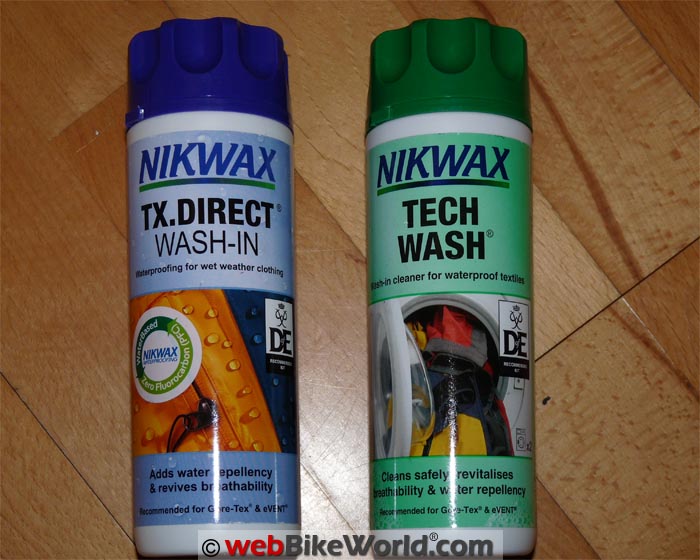
How to Ruin Your Durable Water Repellency
What can ruin your DWR? As your garment is worn, the factory-applied DWR coating can wear off through abrasion and general wear-and-tear. Once a weakness is found in the DWR, it’s a downward spiral because if the fabric on which it has bonded to does soak up water, the fabric swells, weakening the bond between the rest of the DWR and the rest of the fabric. Take a second and think about how you sit on your bike: Certain areas of your garments are touching the bike constantly.
For example the crotch area, an area where gear often leaks first, is always against the tank while your arms will tend to rub along the side of your jacket either while riding or while walking about.
At times I’m even conscious of leaning against a wall in my jacket! Hillwalking or trekking gear, the major market for waterproof membranes and their accompanying DWR coatings, don’t often face the same tests that motorcycle gear does. As we ride we hit the falling water harder and our gear is, arguably, subject to more consistent abrasion than trekking gear.
My counterpoint to that is, people might go hillwalking or trekking once a week but but many motorcyclists need their gear to work everyday if they are commuting and therefore their gear, or rather their DWR, wears out faster. This is where the Nikwax range of products comes in.
It’s fairly easy to tell if your DWR coating has been lost through age or wear and tear because you will notice that, when the fabric is wet, the water spreads over the surface of the fabric rather than beading up and rolling off. All you need to do is turn the garden hose on yourself!
If the result of the garden hose test is a jacket or trousers that have become soaked on the outside but yet have managed to keep you dry inside, then you may be wondering what the fuss is all about.
At this point you are relying completely on your waterproof layer, be it Gore-Tex or other type of waterproof/breathable fabric, to keep you dry. A key issue though is that such a layer will not, on its own, keep you warm, and being covered in what is now an expensive damp cloth is not good for your concentration levels and comfort!
If you were to take your jacket apart you might notice that underneath the outer layer which you see every day is a very thin fabric, sometimes it is almost slimy to the touch. This is the waterproof “laminate”. Examples of this include, again, Gore-Tex but also eVent, Reissa, etc.) which will keep the water at bay but which isn’t all that good at keeping you warm (indeed it is made to be breathable and cool). As such, the DWR coating on the outer layer of the jacket is a vital feature in helping your waterproof laminate to work properly and in keeping you warm so if it’s not working anymore you should refresh it.
Restoring DWR With Nikwax Tech Wash and TX Direct
Nikwax is a UK brand of specialist outdoor cleaning and protecting products and a number of their products are targeted at motorcyclists, including their Tech Wash washing solution and TX Direct DWR refresher. The system is a simple two-step process where you wash your jacket with Tech Wash and then, immediately if you like, coat it with TX Direct.
While you can use Tech Wash on its own to clean a jacket, if you intend on restoring the DWR with TX Direct, you have to wash it first. It can be a time consuming process but yours truly decided to put these products to the test.
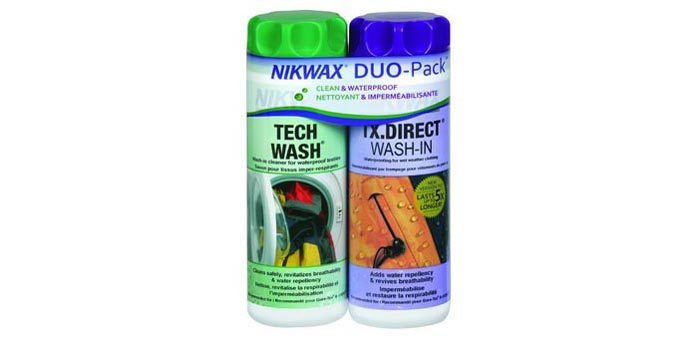
Nikwax Tech Wash
Nikwax Tech Wash is one product in a large field of cleaning products aimed specifically at fabrics such as Gore-Tex with their integrated DWR coatings. You may be wondering why is it not possible to simply wash your jacket with your usual washing detergent (those that you use on your everyday clothing). Well, it is possible, but not all that productive.
The average everyday washing detergent such as Tide in US or Daz or Persil in Europe are said to be particularly harsh on DWR coatings. But a quick Google search will not bring you one definite answer as to why normal detergent will not work. However, from my research, there are two complementary reasons.
One is that normal detergents aggressively break the surface tension of water (remember that was mentioned earlier?!) in order to have water spread throughout fabric fibres to clean them in the washing machine. While this is normally a good thing, it goes against the whole working principle of your DWR coating which encourages the surface tension of water to remain strong so that it doesn’t soak your jacket. The other reason is that detergents which are not soap (which means almost all of the usual suspects in the detergent aisle of your local supermarket) tend to remain on a fabric if not thoroughly rinsed off.
As such, if detergent is not rinsed off it will be activated by rainwater, weaken the surface tension of any rainwater falling on your jacket, and thus encourage it to soak through your DWR. Pure, fat-based soap will just turn to a grease and have no effect on your DWR.
While it is almost impossible to find the exact ingredients for proprietary products such as Nikwax Tech Wash, its Material Safety Data Sheet (.pdf) mentions that the product is slightly alkaline in nature and is not harmful by ingestion.
With its bottle label stating that it is a “non-detergent liquid soap” and that it is a “wash-in cleaner for waterproof textiles”, it’s a fairly safe bet to assume that Tech Wash is just a gentle liquid fat-based soap which rinses easily and is kind to DWR coatings. Indeed this is exactly what I found when I washed my jacket.
Treating the Richa Jacket
The Richa Sky jacket which I was washing had quite a bit of ingrained dirt in it, but that was to be expected from it being in use every day (although the dirt had not really affected the performance of the DWR, what with me having survived a lot of rain through the Irish winter without being wet underneath).
The interior thermal liner was also in need of a wash, having soaked up its fair share of sweat over time. The instructions on the Tech Wash bottle state that, if you are washing the garments in a washing machine, you should clean out the detergent drawer first. This is in order to prevent the Tech Wash from being contaminated by normal washing detergent which could damage the DWR (and then ruin Nikwax’s reputation!).
The first step then was for me to take the detergent drawer from the washing machine and rinse some gunked-up detergent from it.
Considering the amount of effort it took to rid the drawer of all detergent, it was easy to imagine the amount of detergent left behind on clothing after a standard wash.
While it would not be enough to cause skin irritation, it might well be enough to cause rainwater to penetrate your DWR. As an aside, once my washing was complete, I checked the drawer for any signs of Tech Wash residue and there was absolutely nothing there — proving the point that it does indeed rinse off fully.
Once the drawer was clean, I poured two capfuls of Tech Wash into it and closed it before loading the jacket (having first removed the protectors) and I also loaded the thermal liner.
I had other garments that also needed washing, but Nikwax recommends doing just two items per wash to allow them to soak and wash properly.
Washing them on a cool wash (per the instructions on the garments themselves), I watched as the garments were rotated in a mass of suds and bubbles in the washing machine. Once the machine had finished its job, I was pleasantly surprised. The jacket was now by no means free of stains, but it was a good deal cleaner than it had been; the Tech Wash seeming to easily deal with any bug stains or remains left from a day riding. The thermal liner which had also been in the wash came out smelling clean and fresh, unlike the way it had been prior to its wash.
While I inspected the jacket as it drip-dried, it was clear to see that some of the stains were simply too tough for Tech Wash to remove. With my Richa Sky jacket being light in colour, it is easy for any road stains to show up, some of which had had time to be baked into the fabric by heat.
Perhaps this was an indication of a DWR failure in that stains, like rainwater, should not be able to stick to the fabric. Either way, Tech Wash did manage to “lift” the colour of the jacket, which indicated to me that it had managed to wash away surface-level dirt which had built up over time.
The colour of the fabric on the jacket was, especially on the darker grey areas, more vibrant and newer-looking once dry and a stain which I had dabbed some neat Tech Wash on before inserting it into the washing machine, had indeed been washed out pretty well. Perhaps for stronger stains, a little pre-wash application is useful.
It is interesting to note that the hook-and-loop fasteners (Velcro) under the jacket pockets and storm flaps now seemed to work a little better.
My guess being that the Tech Wash removed built-up road grime from the hook and loop system and lifted the “hooks” of the system to ensure it was easier to close. The results were very similar for my Richa Sky trousers — although these do not stain as easily due to them being black in colour.
Once again, the colour of the trousers was “lifted”, the hook and loop fasteners worked a little better and the reflective visibility strips were a little easier to see as they were no longer hidden behind a layer of road grime!
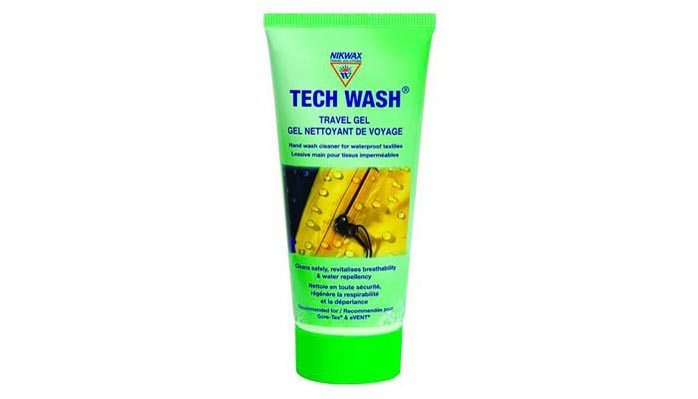
Nikwax TX Direct DWR
While Tech Wash is specifically made so that you do not have to reapply a DWR coating after washing your garments, for the purposes of this test I went ahead and did it anyway. Indeed, I did it just hours after washing the jacket and trousers with Tech Wash, although Nikwax themselves say that you can immediately apply Nikwax TX Direct (their DWR coating) after a wash.
As it was, I needed to take some photos of my clean gear before going back to the washing machine. Then I loaded in my jacket and my trousers, adhering once again to the two-garment-per-wash rule that Nikwax set out.
(A few months back I contacted Nikwax about the two-item rule, because their TX Direct DWR solution can also be used on tents, items with far more surface area than a motorbike jacket and trousers combined.
They recommended a ratio of 100 ml of product to cover 1 square metre of fabric. This is easy with a tent but not so with a jacket and its accompanying layers and sleeves, so it’s easiest to follow the two-garment-per-wash rule).
“Green for clean and purple for proof” is often the mantra used by those who use Nikwax regularly.
The Tech Wash, contained in a green bottle, does the cleaning while the re-proofing, or re-applying a DWR coating, is done by TX Direct from a purple bottle.
Although your jacket might look clean enough for you to apply TX Direct to, it’s probably not, thus the mantra.
This is a little funny, because a descendent of TX Direct, and not Tech Wash, was actually the company’s first product. Nick Brown, the CEO of Nikwax, made the first batch of what was then called “Nick’s Wax” in a small apartment in London in the late 1970s.
It’s from that original solution that TX Direct has been derived and although it is impossible to find out what the exact formulation is, some investigation through old patent applications has made an educated guess possible.
In US patent number 5169891, Nick Brown describes how waterproof coatings can be improved by his invention, which uses EVA (ethylene vinyl acetate), a porous plastic, along with EDTA (a salt), and zirconium acetate (which is related to vinegar!).
The EVA — which smells a lot like PVA glue — is there to ensure that the wax in the solution remains flexible and tough over time while the EDTA is an emulsifier and ensures that the solution covers each and every fiber of your garment in the washing machine.
The zirconium element, if you would like to know, is there to ensure the solution remains bound to the fibres of your jacket and doesn’t simply float off after the washing machine has done its job.
You can read more here if you like. Try and use it by hand without gloves and see your skin become water-resistant! (Ask me how! I’m just glad the whole of the Nikwax range is non-toxic!).
It all sounds fairly complicated, but ultimately the solution is a form of wax which is delivered to your jacket as it is soaked in the washing machine.
The great thing about using your washing machine to apply this DWR is that no seam, crease, zipper or buckle is missed. With it being thoroughly soaked within your washing machine, the solution is able to work its way into places a spray could not.
Not only does this ensure complete coverage, if that is what is needed, but it also means fairly uniform coverage as the DWR only attaches itself to fabric which is clean and missing its coating.
It all seems so simple, but is this how it turned out in reality? The answering is a fairly resounding yes.
With the washing machine dispenser drawer completely clean from my earlier use of Nikwax Tech Wash on my Richa Sky jacket, I put the jacket back in, along with its waterproof membrane, and poured in 200 ml of TX Direct (100 ml per garment is the recommendation).
Setting the washing machine to a cool wash, I watched through the window on the door as the water soaked the jacket, carrying with it the precious TX Direct.
I was optimistic about the result because even as the cycle was beginning to come to an end I could see water beading up on the inside of the door’s window, much as you would see rain bead on a freshly waxed motorbike.
Although some might dispute the fact that I was applying the DWR to my waterproof membrane, TX Direct is made so that it clings just to the fabric and, thus, does not completely cover the microscopic holes which allow vapour to pass through.
The concept of breathability is integral to the Nikwax philosophy and I can’t say that I noticed any less breathability upon using my gear again afterwards.
What I did notice though, as I took the jacket from the washing machine, was the large puddle of water which had made its way to the floor.
Despite the washing machine having spun the jacket to drain the water, some had stayed behind and with the TX Direct not allowing it to absorb into the jacket, it had to go somewhere. Thankfully there was a mop nearby which had not been given the Nikwax treatment!
Due to Nikwax not containing any fluoropolymers, there is no need to use heat to dry it, so simply hanging it outside does the job just fine and after a couple of hours, the jacket was dry enough to use.
Obviously, this meant it was time to test it, so I put my sleeves under the water tap in the sink and watched as a puddle developed!
Since those initial tests, I have been out in pretty nasty rain on journeys of over two hours and the jacket has not leaked.
Strangely though, I did notice after one journey that an area around the shoulder looked as though it was “wetting out”, but further investigation showed the other side of the fabric to be completely dry.
I can’t explain it properly but neither can I blame the TX Direct because the jacket stayed dry underneath.
Besides waterproofing though, the TX Direct also made my zippers work a lot smoother (I’m guessing the wax in the solution lubricated them) while the hook-and-loop fastenings worked a lot smoother as well.
There was no strange smell from the jacket and it feels just about the same as it had felt before the TX Direct was washed in to it.
Longevity doesn’t seem to be an issue either; I have worn my jacket almost every day (as usual) but it still allows the rain to bead up. It seems those hours Nick Brown spent mixing up different preparations of wax have indeed paid off.
(NOTE: TX Direct can also be purchased as a spray but I did not test this version.)
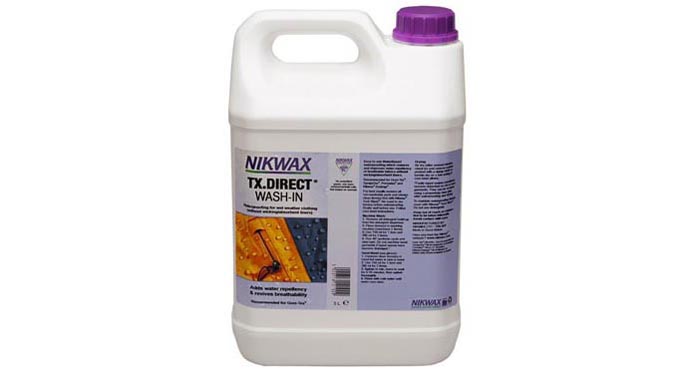
Conclusion
Once again, no one likes a leaky motorbike jacket — but that doesn’t automatically mean that you need to rush out and buy new kit the moment rain begins to soak through it. Despite the fact that modern DWR coatings are derived from some very advanced chemistry, they can very easily be cleaned, revitalized, and re-applied.
The Nikwax range of products is just one family of DWR revitalizing products out there, but they do happen to be the only ones which are free of nasty fluoropolymers and which are actually water-based. Although some might believe them to be less powerful owing to this fact, I found that be untrue.
Tech Wash cleaned my everyday motorcycling jacket as good as I could ever have hoped, while TX Direct is a miracle solution that one can see working even before the wash cycle finishes applying it. So hold on to your Alpinestars catalogue, there might just be life in your old gear yet!
Owner Comments and Feedback
From “K.E.” (June 2015): “I like and use the Nikwax products on Gore-Tex and Event and Windstopper stuff. Learned something new last week: Recently my 6 year old Gore-Tex Held gloves were not keeping water out, especially during a 2 hour highway ride of thunder and rain and darkness. The soaked inner layer mostly turned inside out as I took them off.
I could stand this no more and cut the inner liner off at the cuffs. Next, I see a very thin white liner that’s a little like very thin Tyvek home wrap. Aha — this is the Gore-Tex. Well, it was so thin it had ripped here and there, up my large fingers, across my palm etc. It is not like ripstop nylon; it rips easily and it doesn’t stretch much either. Now I knew why they weren’t waterproof — the Gore-Tex was ripped in multiple places.
The lesson is that no amount of Nikwax is going to make them good again, so I cut that layer out at the cuffs too and am left with just a pair of pretty nice dry weather gloves, kangaroo palms, some protection, gauntlets. Not as nice as their “Steve” model though. Hope this helps your readers or editors or both.”
Editor’s Note: Most Gore-Tex products today have a lifetime guarantee against leakage, so before you do some surgery, you may want to contact the retailer about a possible replacement.
From “D.H.” (June 2015): “Very good article. Many moons ago, I used spray-on products such as Scotchguard or ReviveX, but for the last 10 years or so I’ve given all my Gore-Tex and other “-tex” textile gear (mostly Aerostich, Rukka and Rev’It) the Nikwax wash and re-DWR treatment roughly twice a year. It’s vital to follow Nikwax’s directions to the letter, as well as any cleaning advice from the gear manufacturers (Aerostich is particularly good as providing such advice). Nikwax isn’t inexpensive and I’m a gear whore, so this is a considerable investment, but I find it’s money well spent to keep my gear waterproof and looking and functioning better.
I also throw a few of my nylon necktubes in with other gear I’m treating; they’re not supposed to be waterproof, but the Nikwax adds a helpful degree of water repellency. I’ve also Nikwax’d fleece mid-layers with very good results — the naps fluffs back up a bit, and though one would hope it doesn’t become necessary, any degree of water repellency can’t hurt.
I’ve had hiking/climbing/bicycling outfitters tell me that wash-in DWR treatments impede breath-ability; I don’t know if that’s accurate, but I haven’t noticed it in motorcycle gear. Nikwax, like other treatments I’ve used, may cause your pants to slip a bit on your bike’s seat, though the effect is short-lived.”
From “I.C.” (June 2015): “My experience of using the Tech Wash and then the TX Direct wash in is a positive one. I have a light weight IXS City jacket which is beige (light brown). It has a “water barrier” which I found to be shower proof only. A wash with the Nikwax TX Direct and it is now capable of surviving prolonged heavy rain. The Tech Wash helps keep the light colour clean and prepare it for the TX Direct.
Prior to starting biking I had been using the Nikwax clean and re proofing for years with various jackets. It is a once-a-year job to clean and re-proof the family winter jackets. The only issue is that some jackets end up so heavy after the wash they will not spin, so taking them out of the washing machine means having something to carry them to where they can drip dry without soaking the floor.
There are other Nikwax products handy for bikers. I use the Tent and Gear Solarproof spray on waterproofing on my bike cover to help keep it from leaking. The Nikwax Visor Proof is a small spray that works very well for keeping the rain running off your visor. It will do me for a weeks commute in the winter when it rains each day.
The Glove Proof is a sponge applicator for keeping your gloves water proof and it works on leather and fabric. It rains a lot in Scotland and so I have tested all of the products mentioned in prolonged heavy rain and they do work so long as you keep applying them.”


